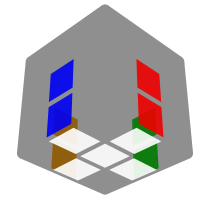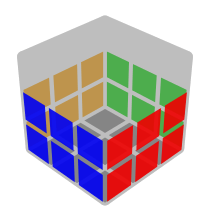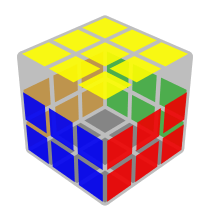CFOP method facts for kids
The CFOP method (Cross – F2L – OLL – PLL), sometimes known as the Fridrich method, is one of the most commonly used methods in speedsolving a 3×3×3 Rubik's Cube. This method was first developed in the early 1980s combining innovations by a number of speed cubers. Czech speedcuber and the namesake of the method Jessica Fridrich is generally credited for popularizing it by publishing it online in 1997.
The method works on a layer-by-layer system, first solving a cross typically on the bottom, continuing to solve the first two layers (F2L), orienting the last layer (OLL), and finally permuting the last layer (PLL).
The Method
- The Cross – This first stage involves solving the four edge pieces in one outer layer of the puzzle, centering around a commonly coloured centre piece. Many speedcubers usually solve the cross on the bottom side to avoid cube rotations and to get an overall better view of the important pieces needed for the next step.
- First Two Layers (F2L) – In F2L, corner and edge pieces are paired up and later moved to their correct location. There are 42 standard cases for each corner-edge pair including the case where it is already solved. It can also be done intuitively.
- Orientation of the Last Layer (OLL) – This stage involves manipulating the top layer so that all the pieces therein have the same colour on top, at the expense of incorrect colours on other sides. This stage involves a total of 57 algorithms. A simpler version, called "two-look OLL" orients edges first and corners afterwards. Algorithms are usually performed two to three times for this version. It uses ten algorithms, three for edge orientation and seven for corner orientation.
- Permutation of the Last Layer (PLL) – The final stage involves moving the pieces of the top layer while preserving their orientation. There is a total of 21 algorithms for this stage. They are distinguished by letter names, usually based on what they look like with arrows representing what pieces are swapped around (e.g., A permutation, F permutation, T permutation, etc.). "Two-look" PLL solves the corners first and edges separately. It uses six algorithms, two for corner permutation and up to four for edge permutation. Also, a U-perm can be repeated if the user wishes to use even fewer algorithms at the expense of usually faster solve times.
There also exist many advanced extension algsets to be used in companion to CFOP, such as COLL, Winter Variation, VLS, ZBLL, and more. However, it is not necessary to learn them in order to solve the cube.
Competition Use
CFOP is heavily used and relied upon by many speedcubers, including Max Park and Feliks Zemdegs, for its heavy reliance on algorithms, pattern recognition, and muscle memory, as opposed to more intuitive methods such as the Roux or Petrus methods. The majority of top speed cubers on the WCA ranking list are CFOP solvers, including the current 3x3x3 single world record holder (Yusheng Du (杜宇生)), with a time of 3.47 seconds.
See also
 In Spanish: Método CFOP para niños
In Spanish: Método CFOP para niños




